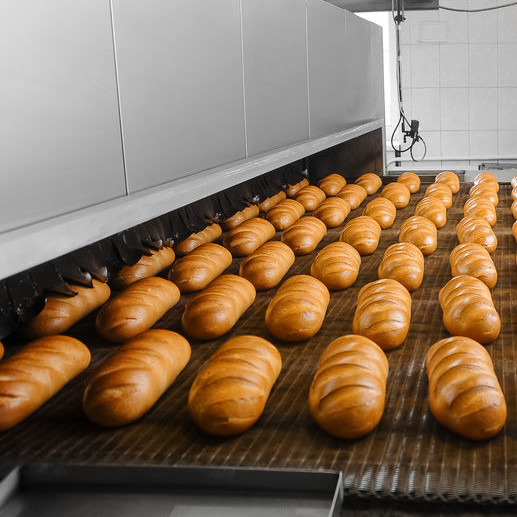
Hybrid Ovens
What are Hybrid Ovens?
Hybrid ovens combine different types of heating systems into one unit. In baking operations, hybrid ovens use conventional heat transfer mechanisms, plus dielectric heating. This is another form of electromagnetic radiation that includes microwave and radio-frequency (RF) heating.1,2
This synergy in heating provides bakers with many advantages:
- A more even bake and heat distribution in the baking chamber
- Rapid heating through the product, without localized overheating or hot surfaces
- Quicker baking times because of higher heating rates and faster water evaporation/bake loss
- Reduced energy consumption
How do they work?
Hybrid ovens combine the following heating mechanisms:3,4
- Radiation (infrared) + convection (natural or forced) + conduction
- Dielectric heating, by microwaves or radio frequencies
The following table is a description of the electromagnetic spectrum. Hybrid ovens use three types of radiation: IR, microwave and radio-frequency.5,1
| Gamma rays | X-rays | Ultraviolet (UV) | Visible light | Infrared (IR) | Microwaves | Radio frequency | |
| Wavelength (m) | ≤ 10×10-12 | 10×10-12 – 10×10-9 | 10×10-9 – 400×10-9 | 400×10-9 – 760×10-9 | 760×10-9 – 1×10-3 | 1×10-3 – 1 | ≥ 1 |
| Frequency (Hz) | 1020 | 1018 | 1016 | 1015 | 1013 | 1010 | 107 |
* 1 nm = 1×10-9 m
Infrared radiation (IR)
Radiant energy emitted by conventional bakery ovens by either indirect or direct gas-fired. Then, the heat is spread through the infrared (IR) spectrum. Oven IR electromagnetic waves range from 760 to 10,000 nm (0.76 to 10 µm). This range is very effective in browning product surfaces. Although, it doesn’t penetrate very far below the surface.5
Dielectric heating
Microwaves of about 12 cm length penetrate the food and agitate water molecules in the dough or batter. This creates friction and heat. Then, that energy spreads through the dough by conduction, and by convection in batters. Microwave radiation only affects water molecules. Waterless materials, such as baking pans, do not get hot from microwave heating.1,2
The depth microwaves penetrate dough or batter and the amount of energy absorbed by the product is determined by:1,2
- Frequency and wavelength of electromagnetic radiation
- Moisture content and composition of product
- Salts in the product
- Product temperature
- Dielectric properties of food: relative dielectric constant ε’ and relative dielectric loss factor ε’’.
ε’ expresses the ability of the material to store electrical energy. ε’’ relates to the ability of the food to dissipate electrical energy and convert it into heat. The higher the loss factor, the more energy is absorbed by the food.1,2
Advantages of dielectric heating
- Much faster heating than IR radiation, convection and other heat transfer forms. This is because energy penetrates the product up to several centimeters, setting all water molecules in motion at the same time.
- Heat is generated quickly and uniformly through the product. So, the center of the product bakes more quickly than the outer surface.
- Speeds up the setting of crumb structure and texture development. Also, it enhances water loss from the center of the product.
- Radio-frequency has a greater penetration depth than microwaves, given its lower frequency and longer wavelengths. This provides higher heating efficiency.
Disadvantages of dielectric heating
- It does not brown the crust.
- Cost of generating microwaves and safety issues involved limits wide spread use in high-speed scenarios.
Application
Dielectric heating alone is not capable of producing high-quality baked goods. Unless, it incorporates other heat transfer mechanisms used in conventional ovens.
The application of microwave ovens in baking is very limited. One of the challenges is that the heating time is very fast. So, often there isn’t enough time for any of the physicochemical changes. Some examples are oven spring, starch gelatinization, protein denaturation, and non-enzymatic browning.6 This can result in dense crumb, poor crust color, and an undesirable moisture distribution in the crumb.6
Challenges with hybrid ovens
While the technology combination in hybrid ovens is quite efficient, it is also costly in terms of capital and operating costs. Also, hybrid ovens come with instrumentation and control systems which require qualified engineers, maintenance personnel and machine operators.
References
- Fellows, P.J. “Dielectric, Ohmic and Infrared Heating.” Food Processing Technology: Principles and Practice, 4th Edition, Woodhead Publishing, Elsevier Ltd., 2017, pp. 813–844.
- Neetoo, H., and Chen, H. “Alternative Food Processing Technologies.” Food Processing. Principles and Applications, 2nd Edition, John Wiley & Sons, Ltd, 2014, pp. 137–141.
- Davidson, I. “Oven Designs.” Biscuit Baking Technology: Processing and Engineering Manual, 2nd edition, Academic Press, Elsevier Ltd., 2016, pp. 73–91.
- Walker, C.E. “Oven Technologies.” Encyclopedia of Food Grains, 2nd Edition, Volume 3: Grain-based Products and their Processing, Academic Press, Elsevier Ltd., 2016, pp. 325–334.
- Davidson, I. “Heat Transfer.” Biscuit Baking Technology: Processing and Engineering Manual, 2nd edition, Academic Press, Elsevier Ltd., 2016, pp. 59–63.
- Peñaloza-Espinosa, J., Calderón-Domínguez, G., et al. “Effect of Baking in Product Quality and Baking Ovens.” Advances in Heat Transfer Unit Operations: Baking and Freezing in Bread Making, CRC Press, Taylor & Francis Group, LLC, 2017, pp. 189–209.

